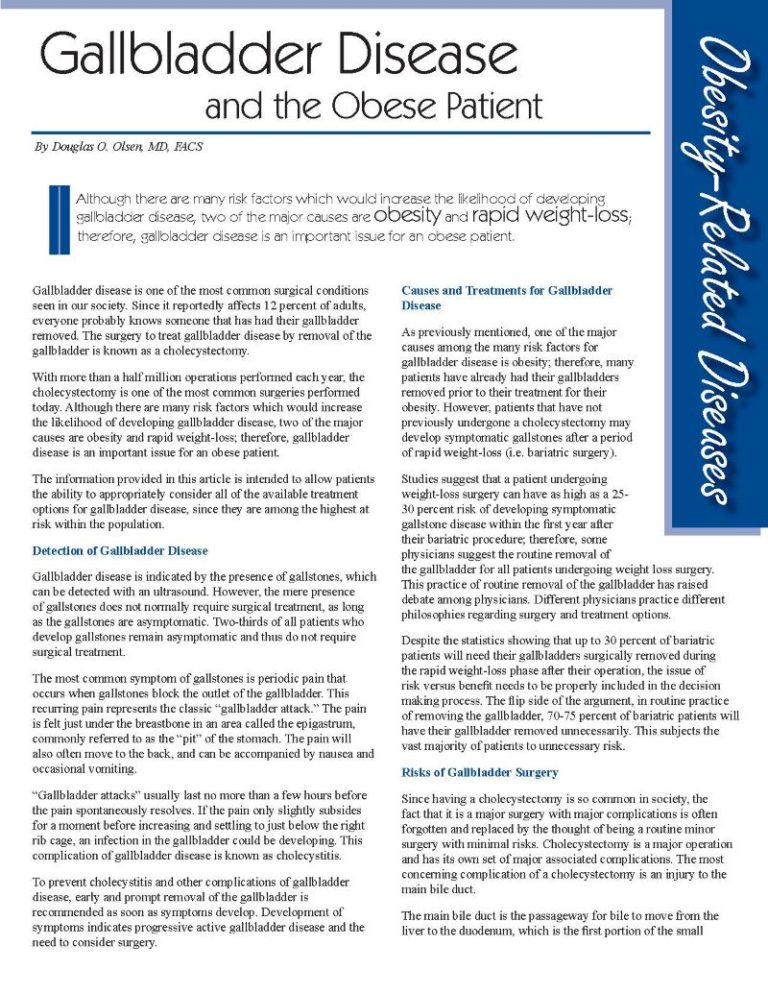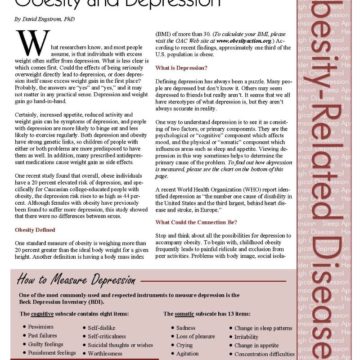Gallbladder Disease and the Patient with Obesity


by Douglas O. Olsen, MD, FACS
Fall 2007
Gallbladder disease is one of the most common surgical conditions seen in our society. Since it reportedly affects 12 percent of adults, everyone probably knows someone that has had their gallbladder removed. The surgery to treat gallbladder disease by removal of the gallbladder is known as a cholecystectomy.
With more than a half million operations performed each year, the cholecystectomy is one of the most common surgeries performed today. Although there are many risk factors which would increase the likelihood of developing gallbladder disease, two of the major causes are obesity and rapid weight-loss; therefore, gallbladder disease is an important issue for a patient with obesity. The information provided in this article is intended to allow patients the ability to appropriately consider all of the available treatment options for gallbladder disease, since they are among the highest at risk within the population.
Detection of Gallbladder Disease
Gallbladder disease is indicated by the presence of gallstones, which can be detected with an ultrasound. However, the mere presence of gallstones does not normally require surgical treatment, as long as the gallstones are asymptomatic. Two-thirds of all patients who develop gallstones remain asymptomatic and thus do not require surgical treatment.
The most common symptom of gallstones is periodic pain that occurs when gallstones block the outlet of the gallbladder. This recurring pain represents the classic “gallbladder attack.” The pain is felt just under the breastbone in an area called the epigastrum, commonly referred to as the “pit” of the stomach. The pain will also often move to the back, and can be accompanied by nausea and occasional vomiting.
“Gallbladder attacks” usually last no more than a few hours before the pain spontaneously resolves. If the pain only slightly subsides for a moment before increasing and settling to just below the right rib cage, an infection in the gallbladder could be developing. This complication of gallbladder disease is known as cholecystitis.
To prevent cholecystitis and other complications of gallbladder disease, early and prompt removal of the gallbladder is recommended as soon as symptoms develop. Development of symptoms indicates progressive active gallbladder disease and the need to consider surgery.
Causes and Treatments for Gallbladder Disease
As previously mentioned, one of the major causes among the many risk factors for gallbladder disease is obesity; therefore, many patients have already had their gallbladders removed prior to their treatment for their obesity. However, patients that have not previously undergone a cholecystectomy may develop symptomatic gallstones after a period of rapid weight-loss (i.e. bariatric surgery).
Studies suggest that a patient undergoing weight-loss surgery can have as high as a 25-30 percent risk of developing symptomatic gallstone disease within the first year after their bariatric procedure; therefore, some physicians suggest the routine removal of the gallbladder for all patients undergoing weight loss surgery. This practice of routine removal of the gallbladder has raised debate among physicians. Different physicians practice different philosophies regarding surgery and treatment options.
Despite the statistics showing that up to 30 percent of bariatric patients will need their gallbladders surgically removed during the rapid weight-loss phase after their operation, the issue of risk versus benefit needs to be properly included in the decision making process. The flip side of the argument, in routine practice of removing the gallbladder, 70-75 percent of bariatric patients will have their gallbladder removed unnecessarily. This subjects the vast majority of patients to unnecessary risk.
Risks of Gallbladder Surgery
Since having a cholecystectomy is so common in society, the fact that it is a major surgery with major complications is often forgotten and replaced by the thought of being a routine minor surgery with minimal risks. Cholecystectomy is a major operation and has its own set of major associated complications. The most concerning complication of a cholecystectomy is an injury to the main bile duct.
The main bile duct is the passageway for bile to move from the liver to the duodenum, which is the first portion of the small intestine at the bottom of the stomach. This complication is reported to occur in 0.5-2 percent of patients undergoing a cholecystectomy and can be a life threatening complication. Some studies suggest that this complication is more likely to occur in difficult cases; difficulty often caused by excessive obesity in a patient.
In addition, for laparoscopic bariatric operations, the placement of the operating trocars (the little tubes that the instruments are passed through during the operation) do not exactly coincide for both a cholecystectomy and a bariatric operation; therefore, the cholecystectomy is more difficult than normal due to reduced visibility and accessibility to the gallbladder from the mal-positioned trocars.
There is also an inherent increased risk when combining two major surgeries, especially given the complexity and length of a bariatric procedure. With the postoperative difficulty associated with an open cholecystectomy, the measure of risk versus benefit does lean toward removing the gallbladder at the time of the bariatric operation. But since today most cholecystectomies are done laparoscopically, the risk of the combined procedures outweighs the benefit of avoiding a possible future operation in a minority of patients.
What is the Consensus?
Looking at all of the information provided in this article, there should be no routine decision made as to whether a patient with obesity’s gallbladder should be removed. If a patient has experienced symptomatic gallstones prior to choosing their treatment therapy, then it is logical and appropriate to perform a cholecystectomy either before or concurrently with the treatment option.
However, the main debate concerns patients with either no stones or asymptomatic gallstones. If the patient is undergoing a laparoscopic bariatric procedure, then the gallbladder should be left intact. The gallbladder can be easily removed if it becomes symptomatic, most likely when the patient has lost weight from a bariatric operation and is using an operative approach designed specifically to remove the gallbladder. This will expose the smallest group of patients to the least amount of risk for the given procedure.
If the patient has documented asymptomatic gallstones and is not a candidate for laparoscopic surgery, then the decision of whether to remove the gallbladder at the time of the bariatric procedure is ultimately a choice for the patient to make after being properly informed of the risks associated with the surgeries.
An additional option available is to use a medication designed to dissolve gallstones during the rapid weight-loss phase and thus treat the problem before it exists. In theory this makes sense, but in practice many patients forget to take the medication and still develop the gallstones.
About the Author:
Douglas O. Olsen, MD, FACS, is a private practice bariatric surgeon who is the Medical Director for the Centennial Center for the Treatment of Obesity in Nashville, TN. He is a member of the American Society for Metabolic and Bariatric Surgery and is recognized along with the Centennial Center for the Treatment of Obesity as an ASMBS Center of Excellence.
by Steph Wagner, MS, RDN Spring 2024 Obesity is a complex disease that often comes with other…
Read Articleby Katherine H. Saunders, MD, DABOM Spring 2024 Menopause probably isn’t anyone’s idea of fun. While this…
Read Articleby Sarah Ro, MD; and Young Whang, MD, PhD Fall 2023 Mary, a postmenopausal woman with a…
Read Article








